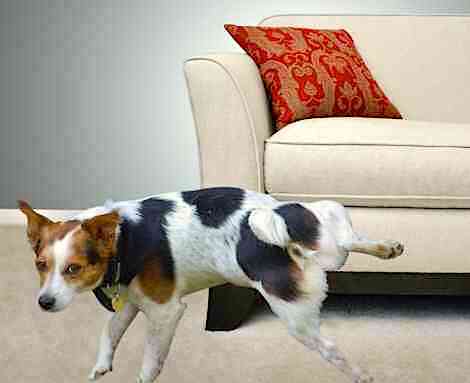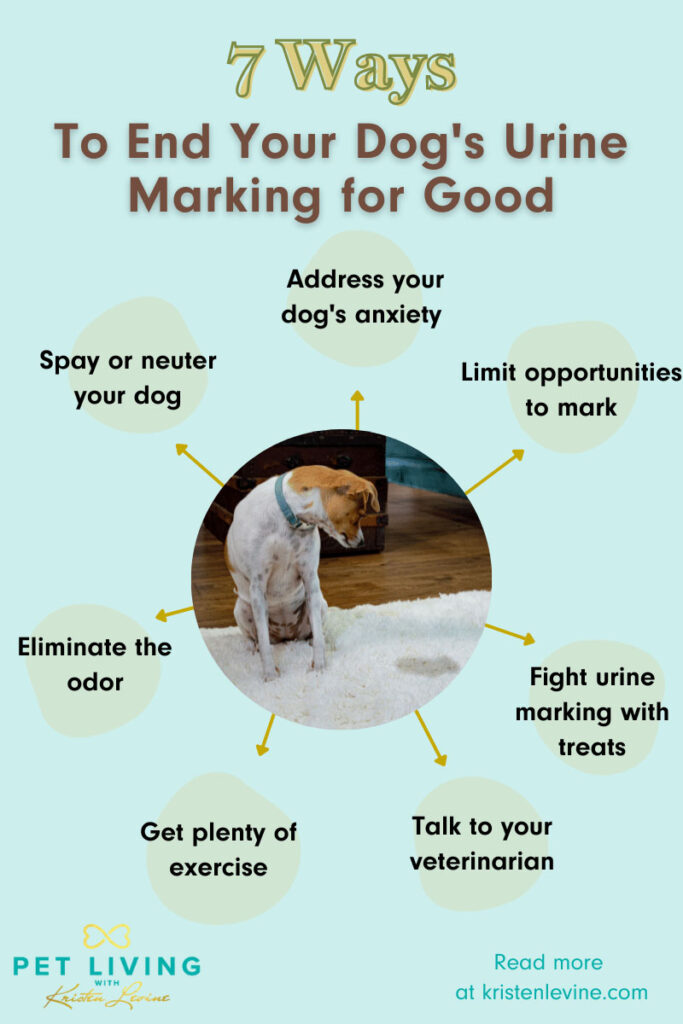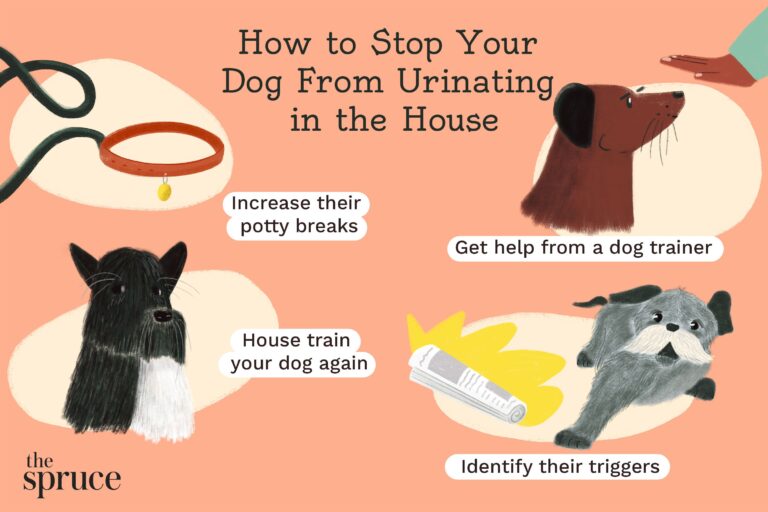To stop dogs from marking in the house, establish a consistent routine for bathroom breaks and positive reinforcement for appropriate marking behavior. Address any underlying medical issues and thoroughly clean any previously marked areas to remove lingering scents.
Providing plenty of opportunities for outdoor exercise and mental stimulation can also reduce marking behavior. Having a dog mark inside the house can be frustrating, but it’s essential to understand the reasons behind this behavior and take proactive steps to address it.
By following some simple strategies and understanding your dog’s needs, you can effectively stop them from marking inside while fostering a positive and healthy environment for both you and your pet.

Credit: m.youtube.com
Understanding Dog Marking Behavior
Understanding dog marking behavior is crucial for stopping dogs from marking in the house. By identifying the underlying reasons behind this behavior, such as territory marking or anxiety, pet owners can implement appropriate training techniques and preventative measures to address the problem effectively.
What Is Dog Marking Behavior?
Dog marking behavior refers to the act of dogs urinating in specific areas of a house to establish their territory or mark their scent. This behavior is more common in male dogs but can also be observed in females. Understanding the reasons behind why dogs engage in marking can help pet owners address and prevent this undesirable behavior.
Reasons Why Dogs Mark In The House
Dogs may mark in the house due to a variety of reasons. It is important to identify the root cause to effectively address the issue. Here are some common reasons:
- Territoriality: Dogs mark their territory as a way of claiming ownership and establishing boundaries. This behavior helps them communicate with other dogs and assert their dominance.
- Hormones: Unneutered male dogs are more likely to engage in marking behavior than neutered dogs. The hormone testosterone plays a significant role in marking, as it triggers the urge to mark.
- New Environment: Dogs may mark in a new or unfamiliar environment as a way to make it feel more like home and establish a sense of familiarity.
- Anxiety and Stress: Dogs may mark indoors when they are feeling anxious or stressed. This could be due to changes in the household, separation anxiety, or other triggers that cause emotional distress.
- Marking on Objects: Dogs can also mark on specific objects, such as furniture or personal belongings, to leave their scent and mark them as their own.
By understanding these reasons, pet owners can take appropriate measures to prevent and curb dog marking behavior. This can include training, environmental management, and addressing underlying anxiety or stress issues.

Credit: canineminded.com
Identifying Marking Versus Urination
Dogs marking in the house can be a frustrating issue for pet owners. To effectively address this behavior, it’s crucial to differentiate between marking and regular urination. By understanding the distinctions, pet owners can take targeted measures to prevent dogs from marking indoors.
Differentiating Marking From Regular Urination
Marking is typically characterized by your dog leaving small amounts of urine in various locations around the home, often on vertical surfaces like furniture or walls. It’s important to note that marking is not a matter of improper house training, as it is a natural behavior driven by territorial and social instincts.
Signs That Indicate Marking Behavior
1. Frequent leg lifting or squatting: Dogs may repeatedly lift their leg or squat to urinate in different spots to establish their territory.
2. Sniffing and marking the same spot: Your dog may repeatedly mark the same spot to reinforce their territory.
3. Selective marking: Dogs may mark specific items or areas that carry the scent of other animals or unfamiliar scents.
Creating A Suitable Environment
Creating a Suitable Environment for your dog is essential in preventing marking behavior inside the house. By understanding your dog’s needs and providing the right environment, you can discourage marking and promote appropriate behaviors.
Keeping An Unmarked Space
Designating a specific area in the house as an “unmarked space” can help deter dogs from marking. This area should be free from any markings and have a neutral scent. By establishing this space, your dog will understand the boundaries and learn where it is inappropriate to mark.
Providing Appropriate Outlets For Marking
Ensuring your dog has access to outdoor areas for marking is crucial. By allowing your dog to mark in appropriate outdoor locations, you can satisfy their natural instinct to mark territory while preventing indoor marking. Regular outdoor walks and playtime in designated areas can fulfill this need.
Establishing A Consistent Routine
Establishing a consistent routine is key to preventing dogs from marking in the house. By providing regular walks, bathroom breaks, and a structured feeding schedule, you can help your furry friend develop good habits and minimize accidents indoors.
Regular Potty Breaks
Establishing a consistent routine is crucial for preventing dogs from marking in the house. One essential aspect of this routine is ensuring your furry friend gets regular potty breaks. Dogs have natural bodily functions and need to relieve themselves regularly, just like humans. By setting specific times for potty breaks, you can help your dog understand when and where they should eliminate waste.
To establish a consistent routine, you should take your dog outside for potty breaks at regular intervals throughout the day. Generally, dogs need to go outside to eliminate waste:
- First thing in the morning
- 30 minutes after meals
- After playtime or exercise sessions
- Before bedtime
By adhering to this routine, you teach your dog when it’s appropriate to go to the bathroom and reduce the likelihood of accidents inside your home. Remember to use a firm, consistent command such as “go potty” or “do your business” during these potty breaks, so your dog associates the command with the action.
Creating A Designated Bathroom Area
In addition to regular potty breaks, it’s important to designate a specific area outside as your dog’s bathroom. This area should be easily accessible and far away from the designated play or living areas in your yard.
To create a designated bathroom area:
- Choose a spot in your yard that is away from high-traffic areas and any outdoor furniture.
- Clear the area of any debris or obstacles that may hinder your dog from comfortably using it as a bathroom.
- If possible, use a consistent material such as gravel, grass, or mulch to cover the area. This helps your dog differentiate the bathroom area from other parts of the yard.
- Place a sign or mark the area using a specific scent or pheromone spray that attracts your dog to that spot.
By creating a designated bathroom area, you provide your dog with a clear signal of where it’s appropriate to eliminate waste. This further reinforces consistency and helps prevent marking behavior inside the house.
Positive Reinforcement And Training Techniques
Train your dog using positive reinforcement to deter marking in the house. Consistent training and rewards for good behavior can help in addressing this issue. Redirect your dog’s attention and provide ample opportunities for outdoor bathroom breaks to reduce indoor marking behavior.
Reward-based Training
Reward-based training is an effective technique to stop dogs from marking in the house. By providing positive reinforcement when your dog exhibits the desired behavior, you can encourage them to repeat it. This technique focuses on highlighting and rewarding the times when your dog avoids marking indoors.To start with reward-based training, keep a close eye on your dog’s behavior and identify the times when they successfully refrain from marking in the house. When you notice this, immediately reward them with treats, praise, or a favorite toy. Providing a reward within seconds of the desired behavior reinforces the positive association.Redirecting Marking Behavior
Redirecting marking behavior is another helpful technique to prevent dogs from marking in the house. This involves providing your dog with an alternative outlet for their marking instincts.One effective way to redirect marking behavior is by creating a designated outdoor area for your dog to relieve themselves. This can be a specific spot in your yard or a pee pad for indoor dogs. Introduce your dog to this designated area and consistently encourage them to use it for eliminating waste. Whenever your dog successfully marks in the designated area, praise and reward them to reinforce the behavior.Another effective technique is to keep your dog’s attention focused on other activities. Provide engaging toys and play games that keep them mentally and physically stimulated. By redirecting their attention and energy towards positive activities, you can decrease the likelihood of marking behavior indoors. Remember, consistency is crucial when using these techniques. Be patient and continue to reinforce the desired behaviors while discouraging marking in the house. With time and positive reinforcement, your dog will learn to associate the designated area or engaging activities with rewards, reducing the urge to mark inside.Some key tips to remember when implementing these techniques are:- Always be proactive and observe your dog’s behavior closely.
- Immediately reward your dog when they choose not to mark indoors.
- Create a designated outdoor area or use pee pads for indoor dogs.
- Encourage and praise your dog when they successfully mark in the designated area.
- Keep your dog engaged with stimulating toys and activities.
- Consistency is key in training and redirection techniques.

Credit: kristenlevine.com
Frequently Asked Questions On How To Stop Dogs From Marking In The House
How Can I Prevent My Dog From Marking In The House?
To prevent your dog from marking in the house, make sure they are properly trained and have regular access to outdoor bathroom breaks. Using positive reinforcement, such as treats and praise, will help reinforce good behavior. Additionally, spaying or neutering your dog can reduce marking behavior.
Consistency and patience are key in preventing this problem.
Why Is My Dog Marking In The House All Of A Sudden?
If your dog is suddenly marking in the house, it could be due to several factors. Changes in the environment, such as the introduction of a new pet or a move to a new home, can cause stress and trigger marking behavior.
Health issues, such as urinary tract infections, may also be a factor. Consulting with a veterinarian can help identify and address the underlying cause.
How Do I Clean And Remove Dog Marking Stains And Odors?
To clean and remove dog marking stains and odors, start by blotting the affected area with a paper towel or cloth to remove as much liquid as possible. Then, use an enzymatic cleaner specifically designed to break down proteins in urine.
Be sure to follow the instructions on the cleaner and thoroughly rinse the area afterwards. Avoid using ammonia-based cleaners, as they can actually attract dogs to mark in that spot again.
Conclusion
Dogs marking in the house can be a frustrating and messy issue for many pet owners. By implementing consistent training, creating a designated bathroom area, and addressing any underlying medical or behavioral issues, you can effectively stop this behavior. Remember to be patient and consistent with your training methods.
With the right approach, you can create a harmonious living environment with your furry friend.



